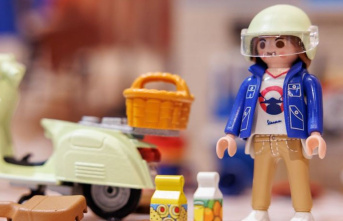Gone are the days when beige was the color of pensioners. The undefinable color—pale, pastel, but not white, brown, or gray—has been making a meteoric comeback for some time. Beige dominates the shop windows of fashion chains, baby boutiques, furniture stores and especially the Instagram and Tiktok feeds. The social networks have contributed a decisive part to the beige hype. Young women from Generation Z stage themselves in their accounts as "Vanilla Girls" and parent content on the platforms presents children's rooms in cream, sand and ocher tones. These millions of posts have now stylized beige into a lifestyle. A flawless, supposedly conscious lifestyle of minimalism, sustainability, closeness to nature - and exclusivity. And that is precisely where there is criticism.
The so-called "Vanilla Girl", whose associated hashtag has more than 630 million views on Tikok, is "the modern girl next door" according to the definition of the "Urban Dictionary", an online dictionary for slang terms. She wears clothes of mother-of-pearl and beige colors. Her wardrobe is minimalist and consists of basics in just these neutral, matte tones. Cable sweaters, silk undershirts, subtle knitted sweaters, blouses with ruffles hang in the closet - all of the best quality, preferably from well-known luxury labels. The "Vanilla Girl" wears fluffy Ugg boots and gold-colored jewelry. She keeps her long, soft, mostly blond hair in its natural state, her fingernails are natural and kept in light tones. The same applies to the make-up: a light foundation, a little mascara and lip gloss are part of the cosmetic equipment. So dictate the video instructions on Tiktok, in which the prototypical "Vanilla Girl" is explained.
"Vanilla Girls" live in tidy, bright and simply furnished apartments, which are dominated by silk, knitwear and fleece. With white curtains, cozy blankets, dried flowers and (vanilla) scented candles, the model girls set up their seemingly perfect world. Here they drink – you guessed it – flat whites, write in diaries and practice yoga or Pilates to maintain a slim figure. "Everything is pastel, soft and lovely, including her personality," summarizes Die Zeit. Vanilla Girls always remain calm and friendly, adds The Urban Dictionary. They lead an unexcited, scandal-free life (there is a maximum of one glass of white wine) and should incidentally radiate pure elegance. In summary: "A pretty white girl with a perfect smile and natural makeup. Feminine, soft and effortlessly beautiful."
Herein lies one of the problems that comes with the vanilla girl hype. The aesthetic focuses on slim, standard-looking white women. A light skin tone and blond hair are presented as particularly desirable. The news portal "Watson" speaks of an "exclusive trend" that suggests that people with a different skin or hair color are not among the vanilla girls and cannot achieve the questionable ideal. But the trend can also exert pressure to be perfect on people who meet external requirements.
"It's about young women who want to appear perfect on the outside, flawless and therefore demonstratively spotless, fragrant, pure," writes the "Welt". As is so often the case with similar phenomena, the appearance that this can be achieved without any problems is illusion rather than reality. There was a lot of effort and money behind the "luxurious minimalism". What looks simple is in fact an expensive pleasure.
The situation is similar with the equipment of the youngsters. The "Vanilla Girls" living and living environment, suitable for Instagram, has made it into the children's room. Many parents today prefer to buy clothes, furniture and toys in beige tones or one of its many nuances such as taupe, ivory and sand (which online shops like to give more elaborate names such as "Hazel" or "Cardamom"). Simple and muted colors, which have long set the tone in contemporary living rooms, now also dominate the children's room. The parents seem to be concerned with forcing their own strict tastes on their offspring, "while banning primary colours, shiny surfaces and fun," criticizes the "Guardian". "Der Spiegel" refers to it as "color withdrawal".
In response to the colorless concept, a counter-movement has formed on social media in recent weeks. US author Hayley DeRoche calls it "Sad Beige". Under the hashtag of the same name, numerous users are now making fun of the children's clothing in beige in an ironic way. In addition to sarcasm, the trend also triggers actual outrage. The colorless environment is bad for the child's development, even some experts fear. "If a room is painted in loud bright colors, it encourages children, they move, are more active," explains Axel Buether, head of the Institute for Color Psychology at the University of Wuppertal, in an interview with "Spiegel".
If children do not have any experience with colors, however, the sense atrophies. "Newborns prefer black and white contrasts and primary colors to colors like beige and gray," confirms Birgit Elsner, professor of developmental psychology and head of the BabyLab at the University of Potsdam, the "Zeit". However, she sees the whole thing less dramatically. In her opinion, the children's room furnishings in beige are not a problem, the child is sufficiently exposed to different colors and contrasts in other rooms and outside the apartment.
Parents from the beige faction like to argue that the color has a calming effect. Because the natural colors stand for peace and balance. "Values that you would also like for the little ones," writes the Austrian Broadcasting Corporation (ORF). No wonder given the many global crises. "Big social issues are always reflected in the color styles of epochs," says Axel Buether. With clear lines and discreet tones, fashion also reflects the permanent insecurity. This may also explain why Generation Z, who grows up in constant crisis mode in times of war and pandemics and is plagued by fears for the future, celebrate the supposedly easy, carefree "Vanilla Girl" lifestyle.
The many dull colors are an expression of the desire for an ideal world that finds ecological and healthy ways of dealing with resources and in which sustainability and authenticity are considered valuable, Axel Buether summarized in the "Spiegel" interview. As with the "Vanilla Girls", the beige home symbolizes a seemingly perfect world. According to ORF, it stands for "alleged minimalism, consumer restraint and closeness to nature". For exactly the ideals that society today considers worth striving for.
Or, as Die Zeit puts it: "Baby beige is the color of parents who always do everything right." The matt tones are reminiscent of undyed cotton, hand-painted wooden toys and sugar-free spelled biscuits and at the same time are a "rejection of gendered pink-light-blue worlds," says the article. That's why moral superiority always resonates in the debate, whether on the part of the beige lovers or from the "Sad Beige" camp. As with the "Vanilla Girls", there is also intellectual superiority, keyword "luxurious minimalism". The children's equipment in beige is usually located in the higher-priced segment. The trend is now also in the baby departments of fashion chains such as H
The discussions, Instagram posts, the hype, the criticism and the counter-movements show that the seemingly harmless trend color beige, at least in the universe of social networks, has obviously been elevated to a signal of perfection - which goes hand in hand with exclusivity, superiority and sometimes toxic expectations . The fact that this tends to counteract the longing for an ideal world and peaceful coexistence is perhaps the real essence of the beige debate.
Sources: "Die Welt", "Der Spiegel", "Die Zeit" (I), "Die Zeit" (II), Austrian Broadcasting Corporation, "The Guardian", "Urban Dictionary", "Watson"











